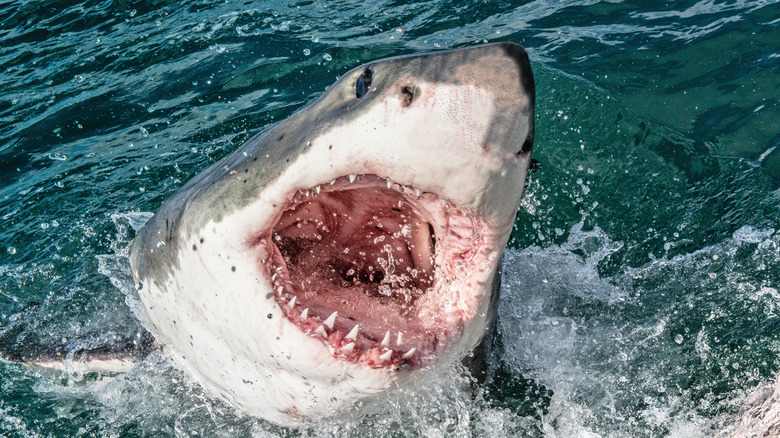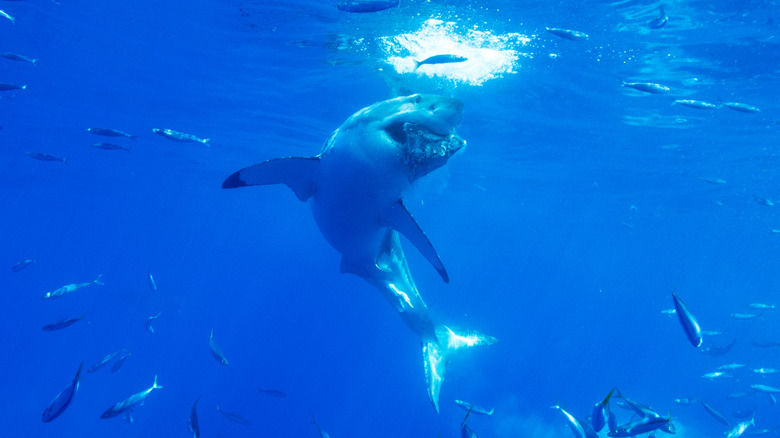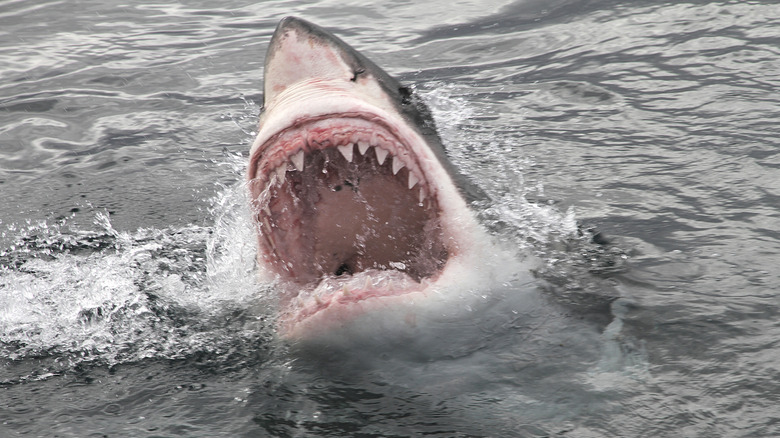The Real Science Behind Jaws Is More Chilling Than Fiction
A giant great white shark with a serial killer mentality, which indiscriminately hunts humans in the waters off the coast of a picturesque East Coast town, is a pretty scary scenario, but the science behind shark biology and how they actually hunt is even more chilling. "Jaws" began life as the 1974 best-selling novel by author Peter Benchley. The next year, director Steven Spielberg turned it into an unforgettable movie — filled with behind-the-scenes mayhem — that left generations of viewers totally freaked out about going into the ocean. Unfortunately, it also led to an increase in sport hunting and the indiscriminate killing of sharks: Humans, it turns out, are more dangerous to sharks than the other way around.
Still, great white sharks are apex predators and are built for hunting. They have one of the strongest bite forces in the animal world and can swim at around 26 miles per hour or even faster, far more rapidly than the average human can run, let alone swim. Their cartilage jaws are attached to the skull by ligaments that allow them to protrude out of their mouths to better grab prey. They also have a lifetime supply of sharp teeth, and the top teeth are serrated to help them tear apart their prey. Great white sharks even have what could be described as a sixth sense that allows them to sense a prey's electromagnetic field.
A shark's sixth sense
Great white sharks, like other sharks and rays, have pores containing mucus around their snouts. Named after the 17th-century ichthyologist who first described them, they are called ampullae of Lorenzini and are electroreceptors that allow sharks to sense electromagnetic fields, including the bioelectric fields generated by living creatures. So not only do great white sharks have excellent vision that helps them see in low-light conditions, as well as an incredible sense of smell able to detect water-borne substances like blood at one part per billion, they can also rely on this sixth sense to help detect their next meal.
Using these receptors, sharks can sense prey that might be hiding in the sand, but can also use them in open water to help hone in on prey in the dark. They can also use this sense to avoid predators (even when they are still embryos) or to look for mates. Once they've located their prey, the great white shark's fearsome teeth and jaws ensure their meal doesn't get away.
A lifetime supply of serrated teeth
The sheer number of teeth within the infamous jaws of a great white shark is incredibly impressive. Typically, the first row, which they use for biting, is made up of around 50 teeth, but behind them can be as many as seven rows with up to 300 teeth, all of which move forward like a conveyor belt when the shark loses or damages a tooth in the front row. Great white sharks can go through as many as 50,000 teeth in a lifetime.
The teeth themselves differ between the upper and lower jaws. On the top rows, great white sharks have large triangular teeth with serrated edges, while the lower teeth are pointed. When the shark attacks its prey, these two types of teeth work together to rip into a meal of a thick-skinned sea lion, dolphin, seal, ray, or even another shark. Because great whites don't chew their food, their two types of teeth help them tear off chunks of flesh that they can then swallow.
Sharks have unique jaw structures
Like all sharks, great whites have skeletons made of cartilage rather than bone. Their jaws are loosely attached to the skull by ligaments and can actually detach from it. This allows the shark to push the upper jaw out of its mouth by contracting certain muscles. At the same time, it can thrust its lower jaw downward, giving this already impressive predator an even wider mouth opening to better grip onto a potential meal. The lower jaw with its pointed teeth strikes the prey first, and then the upper jaw with its serrated teeth comes slamming down. This is an important weapon in the shark's arsenal when hunting fast-moving animals like seals.
Once the shark's jaws clamp down on its prey, it typically makes a fast back-and-forth movement to help tear off pieces of flesh. Surprisingly, the great white's rather flexible cartilaginous jaws don't negatively impact the force with which they're able to bite down on prey.
Great white sharks have incredible bite force and a lot of speed
The bite force that a great white shark can produce puts it near the top of all living vertebrates. This force has been estimated at 4,000 pounds per square inch, around twice that of a lion and 25 times that of a human. Besides having deadly teeth and jaws, great white sharks can move fast. While they typically cruise at around 2 mph, they can reach speeds of between 26 and 35 mph when charging towards prey; an impressive feat for a creature that can be up to 20 feet long.
Famed Olympic swimmer Michael Phelps once raced a great white shark in a 100-meter simulation and lost by a mere two seconds, so it's safe to say no human is going to out-swim one. Thankfully, they don't typically hunt humans; most bites tend to occur either when a shark mistakes a human for its actual prey — mainly seals — or are exploratory in nature. Still, they are one of the most dangerous sharks to humans and are considered one of the "big three" shark species, along with tiger and bull sharks, which together are responsible for most unprovoked shark attacks on people.




